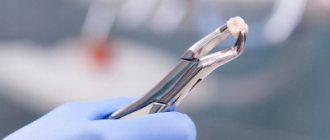Signs of alveolitis
The following symptoms indicate alveolitis of the socket:
- Socket pain that continues or renews on the 3-5th day after tooth extraction. In an uncomplicated postoperative period, it resolves in 1-2 days. At the beginning of the disease it is aching and becomes more intense after eating. At a later stage, the pain is constant and cannot be tolerated; painkillers help for a short time. It can radiate into the ear, into the temple on the side of the sore hole.
- The appearance of a bitter taste and putrid odor from the mouth.
- Enlargement and tenderness of the submandibular lymph nodes.
Upon examination, when alveolitis has just begun, the dentist discovers:
- redness of the gums,
- contents in the form of remains of a loose blood clot, food particles, saliva in the wound,
- that the hole is “dry”;
- in the midst of inflammation:
- swollen red mucous membrane along the edges of the hole,
- soreness when touched,
- there is a gray or yellowish coating on the walls.
Causes of complications after tooth extraction
General disorders of the condition usually occur against the background of the patient’s nervous overstrain, which are associated with fears, often formed in childhood. But technologies are changing, and now treatment by dentists is not accompanied by pain or any other unpleasant sensations. An individual method of anesthesia is selected for each patient to ensure that tooth extraction is easy and painless.
Local complications after tooth extraction can be associated with several factors. The most common of them are:
- anatomical features (cause a root or crown fracture, injury to adjacent teeth);
- careless work of the dentist (improper use of forceps leads to fractures of the tooth or its root, an incompletely separated tooth ligament injures the gum during removal, and when the forceps or elevator slide, damage to soft tissues is caused);
- lack of x-ray control (causes tooth remains to remain in the gum);
- severe carious lesions (provokes fractures of the root or dental crown);
- failure to follow the doctor’s recommendations (excessive or poor hygiene after tooth extraction causes alveolitis or insufficient opening of the mouth during surgery can cause injury to the gums or soft tissues).
Anatomical features that provoke complications after tooth extraction
- The roots are thin and long.
- Thick alveolar walls, which are difficult for the doctor to work with.
- High level of root curvature.
- Hypercementosis.
- Dense partitions between roots.
- If there are many roots, the degree of their divergence is taken into account.
Knowing the causes of complications after tooth extraction, you can prevent their occurrence. But if it was not possible to avoid complications after the operation, it is necessary to immediately proceed to treatment; delaying seeking medical help leads to pathologies.
Causes of alveolitis
Normally, after a tooth is removed, a clot of blood cells and fibrin, the protein from which a blood clot is built, forms in the socket. It almost completely covers the bottom and walls of the alveoli. The clot serves as a mechanical barrier, biological protection against infection and additional injury to the wound surface. In this case, healing occurs by primary intention. The wound is slowly filled first with loose tissue, then with denser connective tissue, and later with young bone.
But there are situations when the healing process is disrupted.
Inflammation of the socket occurs if:
- The operation was highly traumatic, which reduced the protective capabilities of one’s own tissues;
- The blood clot, as the main defense, is broken or completely absent (“dry socket”):
- prolonged bleeding;
- early destruction of the clot;
- non-compliance with the rules of care (for example, increased rinsing, eating hard or too hot food soon after surgery);
- Tooth extraction was carried out for emergency reasons due to an acute infectious process: periodontitis or periodontitis with complications;
- There are common reasons:
- reduced immunity;
- blood clotting disorder;
- elderly age;
- lack of proper dental hygiene.
When white plaque is the norm
Nature intended it so that damaged tissues should be protected from the penetration of infectious agents. This is why, after a tooth is removed, a clot and white plaque forms in the socket. The latter is nothing more than fibrin, a protein needed for blood clotting. It protects the wound surface from infection and does not allow the inflammatory process to spread.
At first, the white film seems very thin, but gradually it turns into bone tissue. Some even mistake plaque for food debris and try to remove it with their tongue or using foreign objects. Under no circumstances should this be done. If the wound heals according to plan, there are no severe pain symptoms, there is no need to worry or touch it. This can lead to complications.
So, fibrin in the form of a whitish coating is needed to:
- the wound healed quickly;
- no infection penetrated into the socket;
- soft tissues were not inflamed.
If the patient has questions regarding the white clot on the surface of the damaged gum, he should consult with his dentist. You don't need to do anything yourself.
Diagnosis and treatment of alveolitis of the socket after tooth extraction
If you have had a tooth removed, but after 2 days the pain in the socket has not gone away, or additional signs of inflammation have appeared, you should not postpone your visit to the doctor. Self-medication can lead to complications such as periostitis, osteomyelitis, and damage to adjacent teeth. The sooner treatment begins, the faster and with less risk of unpleasant consequences the wound will heal.
Even if your tooth was removed in another clinic, our specialists will help you.
Typically, diagnosing alveolitis of the tooth socket is not difficult. A medical history and examination is sufficient. But if necessary, to clarify the depth of the lesion, you may be prescribed additional studies: radiography or radiovisiography.
SM-Dentistry uses only high-quality materials; all instruments are sterilized using powerful sterilizers that eliminate the possibility of infection.
Treatment measures for alveolitis at SM-Dentistry:
- Local anesthesia will relieve acute pain and help you endure treatment.
- Complete cleansing of the wound from parts of the destroyed blood clot, food debris, plaque - a clean wound surface should remain.
- Treatment with disinfectants, antimicrobial and anesthetic agents.
- Application of a special turunda (tampon with medications).
The doctor will give recommendations for further care:
- special baths with antiseptic;
- painkillers;
- gentle diet.
It is possible that treatment of socket alveolitis will need to be supplemented with physiotherapeutic methods.
Alveolitis of tooth socket treatment
The treatment procedure for alveolitis, as well as the inflammatory process in a dry socket, can only be performed by a specialist. Self-medication can lead to an even more painful situation. Taking antibiotics and various rinses are not appropriate here, since in this case they are useless. The dentist will thoroughly clean the inside of the hole, after giving pain relief. Then he will fill the empty hole with a special medicine.
Treatment of alveolitis at the dentist can occur as follows:
1. First, the entire festering clot is removed, this is done strictly under anesthesia. Here the specialist removes all food debris, as well as any plaque that has arisen from the walls of the hole. If the necrotic plaque and everything else are not removed, the infection will spread throughout the entire oral cavity, and treatment with conventional methods will be useless.
2. The hole after alveolitis is completely washed with the help of additional antiseptic drugs. When visiting again, the doctor must change the antiseptic to another.
3. When diagnosing alveolitis of the socket after tooth extraction, special treatment is prescribed.
Prevention of alveolitis at SM-Dentistry
If the operation is not an emergency, then dentists first treat caries and other inflammatory diseases in the oral cavity, which can become a source of infection.
After the operation, you will receive detailed recommendations for caring for the socket so that the blood clot forms correctly and does not break down prematurely. To do this, you must follow a diet (do not eat hard or hot foods), do not use intensive rinsing and cleaning in the area of the injured hole, and use antiseptic and painkillers.
Sign up for a consultation with a dental surgeon by calling 24/7 in Moscow +7 (495) 777-48-06.
Dentist consultation Treatment of caries
Associated complications
In addition to the release of bone material after a sinus lift, there is a risk of developing other complications. They can develop simultaneously with loss of bone material (be a cause or a consequence) or arise for other reasons.
- Inflammatory process . It occurs due to non-compliance with the rules of oral hygiene, ignoring the need for rinsing with antiseptics.
- Sutures coming apart, bleeding . It may be associated with poor-quality suture material, failed sutures, overly active patient behavior, and the development of a hypertensive crisis.
- Perforation of the maxillary sinus . Sometimes during the course of the intervention, due to the small amount of bone tissue, the mucous membrane of the maxillary cave is damaged. This can either remain without consequences or serve as a cause of chronic odontogenic sinusitis.
- Fistula formation . The development of a pathological anastomosis between the maxillary sinus and the oral cavity can occur due to the inflammatory process as a result of perforation of the maxillary sinus.
- Displacement of bone material. When installing an implant at the same time, its dislocation may occur. Occurs due to a gross violation of lifestyle in the first weeks after sinus lifting (sports, blows to the facial skull, etc.). It is also possible due to impaired regenerative processes (lack of adequate healing of bone tissue) or medical error.
These conditions arise in most cases due to non-compliance with the rules by patients.
Prices
| Name of service | Price, rub.) * |
| Initial consultation with a dentist-therapist | 1,500 rub. |
| Repeated consultation with a dentist-therapist | 800 rub. |
| Treatment of caries (imaging, anesthesia, isolation of the oral cavity, installation of an insulating lining and filling made of composite light-curing imported material) | from 4,350 rub. |
| Treatment of alveolitis with socket revision | 3,000 rub. |
We accept VISA, MASTERCARD, MAESTRO bank cards for payment.
Would you like us to call you back?
Symptoms of inflammation
During the normal healing process, the pain after tooth extraction lasts 1-2 days, after which it gradually subsides, the wound becomes covered with a blood clot and heals over time. With inflammation, the pain can come in waves, not subside or even intensify. The nature of the pain is pulsating, can radiate to the ear, and manifests itself after eating. Does not respond to painkillers.
When examining yourself, pay attention to the following signs:
- the gums at the extraction site are red;
- the socket is dry, a blood clot does not form or is quickly destroyed;
- there is a gray or yellow coating;
- bleeding from the socket;
- increased body temperature;
- unpleasant taste and odor from the mouth;
- enlargement of the submandibular lymph nodes.
If at least one of the listed signs is present, you should consult a doctor. There is a suspicion of alveolitis.
Alveolitis after wisdom tooth removal
Indications for the removal of eighth segments in a row can be different: deep caries, improper eruption, orthodontic correction of jaw bite, dystopia, etc. Extraction of third molars is always associated with trauma to nearby tissues, which increases the development of inflammation. The pathological process is observed in 45% of cases due to the removal of lower wisdom teeth.
Symptoms of alveolitis after wisdom tooth removal are similar to the general symptoms of the disease. However, with such localization of inflammation, a sore throat and impaired functionality of the temporomandibular joint on the affected side may occur (difficulty and painful opening of the mouth).
Symptoms of alveolitis
Alveolitis after tooth extraction appears after 2–3 days, and the first signs of the disease cannot be ignored.
Symptoms of the development of complications:
- severe pain in the area of the empty socket
- increasing severity of pain and its spread to the gums and adjacent teeth
- temperature rise to 38–39 degrees
- deterioration in general health
- gray plaque on the socket of an extracted tooth
- bad breath
- enlargement of regional lymph nodes
- swelling and redness of the gums in the area of the extracted tooth
- the appearance of a pus taste
If after tooth extraction you notice one or more of the above symptoms, immediately seek help from a doctor.










